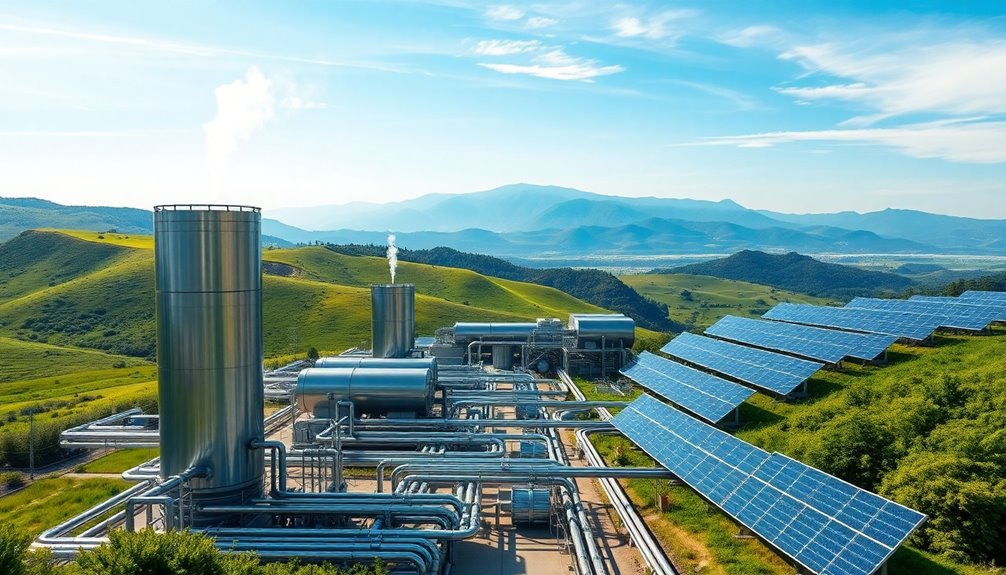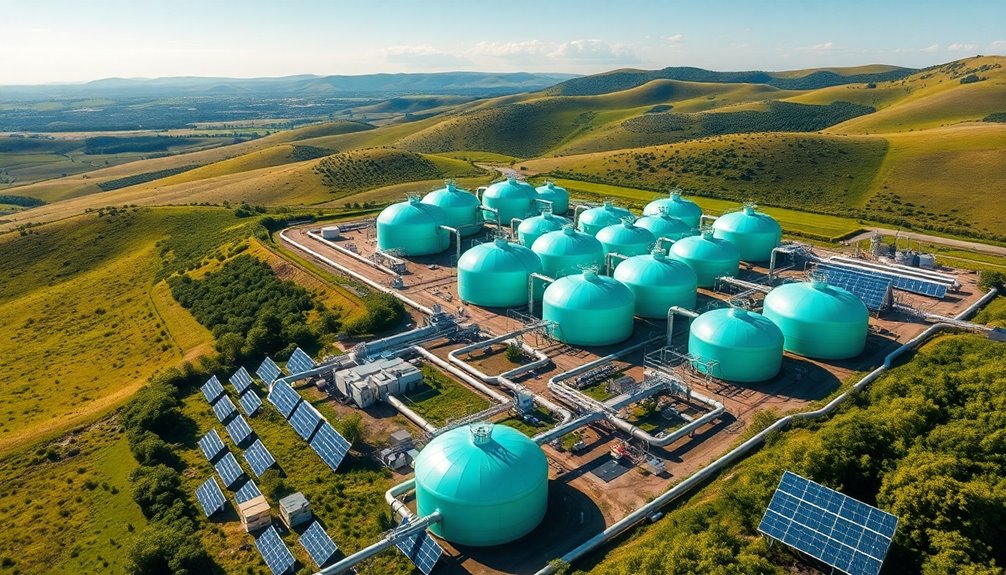Green hydrogen is promising as a clean fuel of the future, produced mainly through renewable-powered electrolysis that emits only water vapor. It offers significant environmental benefits by reducing greenhouse gases and helping industries shift to low-carbon operations. With ongoing technological advances and expanding infrastructure, green hydrogen could support a sustainable energy system and decarbonize sectors like transportation and manufacturing. Discover how innovation and investment are shaping its potential to revolutionize global energy.
Key Takeaways
- Green hydrogen is produced via electrolysis powered by renewable energy, resulting in near-zero emissions.
- It offers a sustainable alternative to fossil fuels in industries like steel, chemicals, and shipping.
- Advancements in electrolyzer technology and renewable energy reduce production costs and improve efficiency.
- Green hydrogen supports energy storage, grid stability, and cross-border renewable energy trade.
- Its growing market and infrastructure development position it as a key clean fuel for the future energy system.
How Green Hydrogen Is Produced

Green hydrogen is produced mainly through the process of electrolysis, which uses renewable energy sources like solar, wind, hydroelectric, or geothermal power. In this process, electricity from these sources splits water into hydrogen and oxygen. You feed water into an electrolyzer, where an electric current causes the water molecules to separate. The main equipment, electrolyzers, come in types like alkaline, PEM, or solid oxide, with PEM being highly efficient. The hydrogen gas generated is clean and environmentally friendly, with a minimal carbon footprint. This method is scalable and relies on renewable energy, making it a sustainable choice. Additionally, the development of advanced electrolyzer technology continues to improve efficiency and reduce costs. As research progresses, cost reduction is expected to make green hydrogen more economically viable for widespread use. Improving electrolysis efficiency is crucial for the future of green hydrogen production, as it can significantly lower overall costs. Integration of renewable energy sources can further optimize the electrolysis process, leading to more consistent hydrogen production. While costs and infrastructure development pose challenges, ongoing technological advancements aim to improve efficiency and reduce expenses, paving the way for broader green hydrogen adoption.
Environmental Benefits and Sustainability Aspects

Producing hydrogen with renewable energy sources results in near-zero greenhouse gas emissions, making it a highly sustainable alternative to fossil fuels. When powered by renewables, electrolysis releases only water vapor, markedly reducing CO₂, nitrogen oxides, and particulates, which improves air quality and public health. It helps decarbonize industries like steelmaking, shipping, and aviation that are hard to electrify. Pairing electrolysis with renewable energy can achieve near-zero lifecycle emissions and reduce reliance on fossil fuels, lowering your overall carbon footprint. Additionally, excess wind and solar power can be stored as hydrogen, supporting grid stability and providing long-term energy storage. This approach promotes a cleaner environment, addresses water resource concerns, and advances sustainable development across sectors.
Key Applications in a Low-Carbon Economy

As industries adopt sustainable practices, hydrogen’s role in a low-carbon economy becomes increasingly essential. You can see its impact in decarbonizing heavy industries like steel, where hydrogen replaces coal in direct reduced iron processes, lowering CO₂ emissions. In chemicals and fertilizers, green hydrogen replaces grey hydrogen, making ammonia synthesis more sustainable. Cement manufacturing could benefit from hydrogen in high-temperature heating, reducing fossil fuel reliance. Hydrogen also supports oil refining by aiding in desulfurization and hydrocracking, cutting emissions. In transportation, green hydrogen derivatives like ammonia and methanol serve as zero-carbon marine fuels, while hydrogen fuel cells power heavy trucks. Additionally, hydrogen facilitates seasonal energy storage, balancing renewable grids, and enables cross-border trade, with resource-rich regions exporting to energy-dependent nations. These applications are crucial for building a resilient, low-carbon economy. Understanding potential allergy risks associated with various seeds can help in making safer choices when integrating plant-based fuels and other bio-based resources into industrial processes.
Technological Hurdles and Opportunities

Despite its promising potential, the development of scalable and efficient electrolysis systems faces significant technological hurdles. Energy losses during electrolysis can reach 80%, reducing overall efficiency. Current electrolyzers degrade quickly, leading to frequent replacements and higher costs. Additional onsite compression adds complexity to infrastructure. Only 0.1% of hydrogen is produced via electrolysis, mainly due to limited market penetration. Relying on excess renewable energy is necessary to avoid grid strain, but this limits scalability. Integrating renewables faces challenges like grid congestion, intermittency, and land-use conflicts. Storage also poses difficulties: hydrogen’s low energy density demands costly compression or cooling, while transportation incurs high expenses and safety concerns. Advancements in catalyst materials, membranes, and hybrid systems offer opportunities to overcome these hurdles and *liberate* the full potential of green hydrogen. Exploring innovative cost-effective solutions can further accelerate the adoption of electrolysis technology and improve its sustainability. Furthermore, ongoing research and development are essential for unlocking new breakthroughs that could dramatically improve efficiency and reduce costs, making green hydrogen a more viable clean energy option. Moreover, expanding retirement planning can help fund investments in advanced clean energy infrastructure, supporting long-term development goals.
Economic Factors Shaping the Market

The green hydrogen market is experiencing rapid growth driven by global efforts to decarbonize energy systems and significant investments from both public and private sectors. You’ll notice the market value hit USD 7.98 billion in 2024 and is projected to grow at a CAGR of 38.5% through 2030. This expansion is fueled by increasing demand for clean energy, government policies, and technological advances that lower costs and boost efficiency. However, high upfront costs, especially for water electrolyzers and renewable energy, present challenges. You should also be aware that government incentives, like tax credits, and funding programs are key to overcoming these hurdles. As investments rise, green hydrogen’s economic potential grows, promising new opportunities and a shift toward sustainable energy sources. Material availability plays a crucial role in supporting the large-scale adoption of green hydrogen, and understanding solar panel configuration can help optimize renewable energy input for electrolyzers. Additionally, implementing robust cost analysis can aid stakeholders in making informed decisions to navigate financial barriers and maximize returns. Moreover, addressing supply chain issues is essential for ensuring the consistent availability of critical components needed for production and deployment.
Its Role in the Global Energy Transition

Green hydrogen is emerging as a key driver in reshaping the global energy landscape. It offers a clean, versatile alternative to fossil fuels, especially for sectors that are hard to electrify. By integrating renewable energy sources like solar and wind, green hydrogen enhances the effectiveness of renewables and helps reduce greenhouse gas emissions. Its potential to decarbonize industries such as steel production and long-haul transportation makes it essential for the energy transition. Governments and businesses are investing heavily, anticipating exponential growth in demand over the next two decades. Despite current challenges like high costs and infrastructure needs, scaling up production will boost efficiency and make green hydrogen more accessible. As a result, it plays a pivotal role in creating a sustainable, diversified energy system worldwide. Advancements in renewable energy technologies will be crucial for lowering production costs and expanding green hydrogen applications globally.
Frequently Asked Questions
What Are the Safety Considerations for Storing and Transporting Hydrogen?
You need to understand that storing and transporting hydrogen involves risks like flammability, leaks, and material embrittlement. To stay safe, install leak detectors, use explosion-proof equipment, and choose resistant materials. Follow strict safety standards, plan routes carefully, and train everyone involved. Regular maintenance, proper ventilation, and emergency plans are essential. Staying vigilant and adhering to safety protocols help prevent accidents and ensure safe handling of hydrogen.
How Does Green Hydrogen Compare to Other Renewable Energy Storage Options?
Imagine comparing apples to oranges in a basket—each has unique qualities. Green hydrogen offers long-term, scalable storage and high energy density but suffers from low efficiency and high costs. Batteries excel in short-term, high-efficiency storage but are less suitable for large-scale, seasonal needs. You’ll find hydrogen ideal for industrial applications, while batteries shine in residential and grid-scale storage, making each a essential piece of the renewable energy puzzle.
What Policies Are Most Effective in Promoting Green Hydrogen Adoption?
You should focus on policies that set clear national goals and provide financial incentives, like subsidies and tax credits, to attract private investment. Developing infrastructure, fostering international cooperation, and establishing standards guarantee safe and efficient deployment. Regularly tracking progress helps stay aligned with global decarbonization. Prioritizing high-value sectors and supporting innovation through R&D funding further accelerates green hydrogen adoption, making it a practical, sustainable energy solution.
How Scalable Is Green Hydrogen Production for Global Energy Demands?
You wonder how scalable green hydrogen production really is to meet global energy needs. Right now, electrolyzer capacity is expanding, but utilization remains low, and costs are high. To truly scale, you need strong policies, stable regulations, and investments in renewable energy. Although projections show significant growth, reaching the required capacity by 2030 or 2050 depends on overcoming financial, regulatory, and technological hurdles, making large-scale deployment challenging but possible with concerted effort.
What Are the Environmental Impacts of Large-Scale Hydrogen Infrastructure Development?
The current question asks about large-scale hydrogen infrastructure‘s environmental impacts. You should consider that expanding infrastructure demands extensive land, threatening habitats and biodiversity. It can also disrupt marine ecosystems and compete with agriculture, risking food security. High-pressure storage and transport pose explosion risks, while leakage contributes to climate warming. Additionally, infrastructure development may disproportionately affect marginalized communities and lead to land-use conflicts, requiring careful regulation and sustainable planning to minimize harm.
Conclusion
As you explore green hydrogen’s potential, remember it’s projected to account for over 15% of the world’s energy use by 2050. This clean fuel could revolutionize industries and considerably cut carbon emissions. While technological and economic challenges remain, your support and innovation can help unleash its full potential. Embracing green hydrogen today paves the way for a sustainable, low-carbon future you can be part of, making a real difference for our planet’s health.









